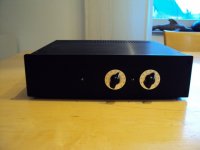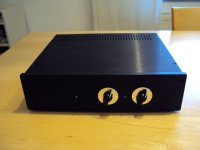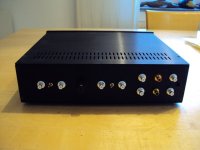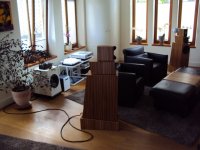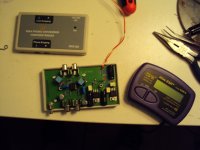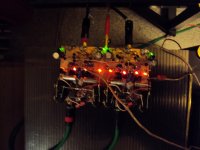Today i build the cascoded MPP. It worked fine right away. I will call it MPP Nova to differentiate it from older designs. Some people here do not like cascoding and yes, the sound got more transparent so flaws in the source may be audible more. I myself liked the sound very much. I have given up on DC coupling the MPP to the next stage, so i am using a coupling cap now. The quality of that cap is crucial and everybody has it´s own preference here. The Wima MKT2 i used initially added some sharpness but i found an excellent substitute. The sound is a very good combination of transparency, tonal balance and dynamics, very close in sound to the JG-Self so this is my new benchmark now. Every circuit that is more complex must play against this now. The transformer balanced inductive stagae is a good candidate but it is much more complex and expensive to make.
Attachments
Question: What about a higher supply voltage and lifting the bias voltage of the cascode transistors in the input stage to some 9-12 volts? This might increase the linearity of the FETs.
Question: What about a higher supply voltage and lifting the bias voltage of the cascode transistors in the input stage to some 9-12 volts? This might increase the linearity of the FETs.
From my experience with 2SK147/170/369's, the iotimum voly=tabge is around 7V.
Less and they are decidedly non linear, more, then the noise rises but there is no gain in linearity.
Regards, Allen
Yes, the circuit can be run on much higher voltage now. I use 12V simply because i use 12V batteries. I found that the Fets are most happy at less then 5 V but i looked more at the noise. I will try higher voltage and i am also working with my team on a discrete OPamp. This Opamp has some very interesting properties namely an open loop bandwidth of 40kHz and 0.01% open loop distortion with a gain of 70dB. Noise is low too at around 2nV/qHz and it can drive 70mA in class A. Still, the circuit as shown, even with the old NE5534 sounds pretty decent. I build it more or less from scrap. It fits on an Euro card and costs very little. I have a lot of expensive phonostages at home that do not even come close, it´s that good.
Hello Joachim
Will you be swapping parts on the Jan Diddens Pax amplifier to see if you can effect the sound quality.
One of the things I find about your methodology for sound evaluation is that you almost have no reference point , almost everything in your system gets swapped apart from your speakers.
My point is do the findings that you make about sound quality of components translate into other systems.
I would of thought that a good way to testing your phono stage was to put an inverse RIAA before your phono stage feed by a CD source that you can switch either through the RIAA or bypass the RIAA Pre and check the sound quality difference between the two , and the more it sounds like the CD source the better your RIAA Pre is. Is there something missing with my reasoning.
Regards
Arthur
Will you be swapping parts on the Jan Diddens Pax amplifier to see if you can effect the sound quality.
One of the things I find about your methodology for sound evaluation is that you almost have no reference point , almost everything in your system gets swapped apart from your speakers.
My point is do the findings that you make about sound quality of components translate into other systems.
I would of thought that a good way to testing your phono stage was to put an inverse RIAA before your phono stage feed by a CD source that you can switch either through the RIAA or bypass the RIAA Pre and check the sound quality difference between the two , and the more it sounds like the CD source the better your RIAA Pre is. Is there something missing with my reasoning.
Regards
Arthur
Last edited:
I would of thought that a good way to testing your phono stage was to put an inverse RIAA before your phono stage feed by a CD source that you can switch either through the RIAA or bypass the RIAA Pre and check the sound quality difference between the two , and the more it sounds like the CD source the better your RIAA Pre is. Is there something missing with my reasoning.
r
I believe there is. A good vinyl system has VASTLY more resolution and life than any 16/44 CD system, so you'd be doing this test with a substandard medium. Rather like finding the next potential Formula 1 champion with a taxi driving contest.
I have heard Joachum's system (with my big poweramps), and it was to die for. And I believe his 30+ years in the hi-end game has given him a background of experience that allows his judgement to rise above being fooled by dead end paths in his research.
It seems to me that Joachum follows similar concepts to me, that components are far less important than circuit topology - but they are still, of course very important.
Regards, Allen
I have not posted here for quite a while but have been following the thread closely.. I had some minor health problems which are now back under control.
It does take a lot of experience - born of years of attentive experimentation - to take this (intuitive) approach....also a very good ear in terms of retention of individual experiences over a large time-scale is required. A lot of such judgement is based on an intuitive knowledge that "this" will work whereas another approach, even if instruments say it should be better, very often gives disappointment. This does NOT infer that knowledge or method is lacking - but does infer that the brain has a potential to cross reference all known and experienced factors very accurately from a memory bank which covers a long time period. Further it is probable that the filters engaged by the brain are far more advanced than those yet available in the world of artificial intelligence. Those who are lucky enough to have the potential to work in such a manner do not need to have the typical references included in the chain. From my own experiences with another designer I have the knowledge that such people can always explain after the fact the reasons for their intuitive decisions......it is not magic!
Hello Joachim
Will you be swapping parts on the Jan Diddens Pax amplifier to see if you can effect the sound quality.
One of the things I find about your methodology for sound evaluation is that you almost have no reference point , almost everything in your system gets swapped apart from your speakers.
My point is do the findings that you make about sound quality of components translate into other systems.
I would of thought that a good way to testing your phono stage was to put an inverse RIAA before your phono stage feed by a CD source that you can switch either through the RIAA or bypass the RIAA Pre and check the sound quality difference between the two , and the more it sounds like the CD source the better your RIAA Pre is. Is there something missing with my reasoning.
Regards
Arthur
It does take a lot of experience - born of years of attentive experimentation - to take this (intuitive) approach....also a very good ear in terms of retention of individual experiences over a large time-scale is required. A lot of such judgement is based on an intuitive knowledge that "this" will work whereas another approach, even if instruments say it should be better, very often gives disappointment. This does NOT infer that knowledge or method is lacking - but does infer that the brain has a potential to cross reference all known and experienced factors very accurately from a memory bank which covers a long time period. Further it is probable that the filters engaged by the brain are far more advanced than those yet available in the world of artificial intelligence. Those who are lucky enough to have the potential to work in such a manner do not need to have the typical references included in the chain. From my own experiences with another designer I have the knowledge that such people can always explain after the fact the reasons for their intuitive decisions......it is not magic!
Dear Pheonix! It may be hard to except and psycho acoustic research has shown otherwise, i have excellent aural memory. That was trained over a period of over 30years working in the audio industry. I must have set up over 1000 systems in that period of time and when especially at shows i got a lot of favoural comments about the sound of our systems. Usually listeners report a very particular and convincing sence of 3 dimensional imaging and the feeling that real people play in real rooms. I did a lot of research how to build loudspeakers that can do that and fortunately i was still young when i found the solution. Maybe you understand my aproach better when i tell you that my reference is acoustic music played on natural instruments in real rooms and not a piece of equipment. It is easy to build a phonostage that passes the invers RIAA test with CD as source. On the other hand i know that reality is not on a recording, it is only a blueprint with a lot of missing information so often with equipment of superiour resolution you end up with unpleasant sound. My goal is to balance technical advances
against musicality, so equipment that measures best and sounds best is the theoretical ideal i also strive for, but we are not living in a perfectly static and predictable world.
Concerning the PAX i will not swapp components until Jan tells me to do it. I respect his work as a piece of Audio Art and when it has any "flaws" so be it.
against musicality, so equipment that measures best and sounds best is the theoretical ideal i also strive for, but we are not living in a perfectly static and predictable world.
Concerning the PAX i will not swapp components until Jan tells me to do it. I respect his work as a piece of Audio Art and when it has any "flaws" so be it.
The sound is a very good combination of transparency, tonal balance and dynamics, very close in sound to the JG-Self so this is my new benchmark now.
The input stage is now conceptionally very close to Syn08's HPS3.1. Since I build the HPS, I lost my motivation to build anything else...
The sound is just as you describe.
Rüdiger
Last edited:
Yes, i learned a lot from Syn08, especially not being afraid of complexity when it gives a technically undisputable advantage. His knowlage about noise is quite amasing too. I will move on and try to crack the 0.3nV/qHz barriere and also do the operational amplifiers discrete. Transformers and coils will come to the rescue too and i have the advantage that i life only 10 minuts from one of the best unsung experts on coils and transformers,
Jürgen Hensler. Yesterday he showed me a transformer he made for a single ended 300B that is -3dB at 450kHz and -12dB at 900kHz without overshot. When I see something like that i feel very small as a craftsman.
Jürgen Hensler. Yesterday he showed me a transformer he made for a single ended 300B that is -3dB at 450kHz and -12dB at 900kHz without overshot. When I see something like that i feel very small as a craftsman.
The input stage is now conceptionally very close to Syn08's HPS3.1. Since I build the HPS, I lost my motivation to build anything else...
The sound is just as you describe.
Rüdiger
Thanks, but others may disagree. Apparently the editor(s) of this web site did not found my work on low noise phono stages being worth of a citation in the DIYAudio newsletter; most likely, a two JFET single ended phono stage is much better
 .
.Onvinyl, i think it is sad that you did not develop your stage further. Nothing can compete with doing something worthwhile yourself even when it is not the best design in the world.
I found your circuit fascinating.
I found your circuit fascinating.
Thanks, but others may disagree. Apparently the editor(s) of this web site did not found my work on low noise phono stages being worth of a citation in the DIYAudio newsletter; most likely, a two JFET single ended phono stage is much better.
Syn08 you should be commended on your work on the phono stage , your work is excellent and it shows a very valid design approach. What is striking about your work is that it sets a good benchmark that others can chase like Joachim wanting to crack the" the 0.3nV/sqrHz barrier".
Just making a phono stage with low noise and accurate RIAA and low THD as you know is a serious amount of work , and a lot of people dismiss your work because they think your approach is just technical, but what you have done also is set a good bench mark which even non technical people will attempt to chase.
Regards
AR
Today i finished the case for the JG-Self i will use on the Frickelfest. After harsh critique from my family using the funny knobs i redesigned for a retro guitar amplifier look and now everybody seems to be happy. I added a mono switch and a line input. It has two outputs, one with 75 Ohm and one with 10 Ohm for a headphone or for driving my subwoofer. I also can switch between two phono inputs. One with 20 Ohm input impedance differential and one with high impedance in the form of an INA made with 3 seperate Opamps.
Attachments
Today i set up the Clearaudio Turntable with Lyra Delos in a friends house. Allen Wright has borrowed me a preamp because i had some trouble with the Tent Labs Volume Control. I can not get the preamp hum free. I tryed to put the mains transformer out of the case but that did not help eather. I will visit Tent Lab next week and i hope they can fix the problem. Unfortunately there was no instuction and i could also not find the diagram. The website says that they are working on the instructions but that does not help now. Thanks Allen for helping me out. We got very good sound and when you want to know more send me a PM.
Attachments
After some rest in the afternoon i setup my own MPP that i had rebuild to Nova spec yesterday. I works fine and is very compact. It was quite a surprise going from the very lifely Clearaudio ( and i mean that positive) to the more quiet Spiral Groove. I have to listen more tomorrow.
I have told you before that i was searching for a simple, good sounding phonostage that i can recommend to my ( poor ) musician friends. They have no trouble buying a vintage Gibson for 10.000,-€ but when it comes to HIFI equipment .......
After i bought some cheap stages for around 30,- to 50,- € i found only junk inside.
The slowest Opamps you can find, the cheapest ceramic caps that should be forbidden,
powersupplyes that do not deserve that name etc. I did a major efford on one stage i have discribed here but i got simply tired of fixing the oscilation problems. Now i had much more success. I bought a kit from ELV, a big German supplier that sells decent quality for very good prices. This time the quality of the parts was much better with 1% metal films, Siemens MKT caps and NE5532. I paticular like the nice PCB. At the end i used only 30% of the parts but the basic layout was fine. It struck me that nobody sofar has tryed to make an MC phonostage with just one Opamp. An exception is Allen Wright external stage that uses a current feedback amp. I do not know if he uses a seperate output stage. Modern Opamps have a lot of gain, even at 20kHz and when we relax our goals of lowest noise and highest overload margin we can do something very simple that works. So first an OPamp had to be chosen. The NE5532 is not bad but i need a bit less noise for MC work and it should also work with MM. In the end i took an LME49720. Voltage noise is 2.7nV/QHz. 10 years ago this whould qualify as low noise but some geniuses here have set entirely new standarts. Do i want to sell laboratory precission equipment to the poor ? No, not this time. A simply tryed to do it as simple as posible. I put a lot of thought into the RIAA cap and resistor values and i did not scimp on parts selection. Having studied the two most famous "simple and cheep" phonostages, the VSPS and the Torsten Loesch El Cheepo it ocured to me that both peak in the audible range and use very high value resistors and low value caps. I am not a big friend of the Neumann pole although i found it not objectianable in Allens tube pres. My silicon stages sounded all too bright when i implemented it. So i choose the values carfully so that they do not peak in the audible range. I also build in a tiny bump in the range around 100Hz ( +0.4dB) and a slow subsonic filter. This whould still qualify as +-0.2dB with 0.1% resistors and 1% caps and has the advantage that the tonal balance is ever so slightly warm plus a measure of rumble suppression of the cheaper turntables used. There are not many parts in this design so i used really good components. Nonmagnetic 1% silver mica, 1% Styroflex, 0.1% Dale nonmagnetic resistors, Pannasonnic FM and Nichicon LG elcaps. The PSU is simple but effective. I decoupled substantially and use a 12V lead battery. Hum is really low and the sound surprised me. If i whould be a marketing guy i whould describe this stage in the following way : Very short signal path, under 4cm ; no cables, jacks directly soldered to the board; antimagnetic enclosure, floating powersupply, low noise precission opamp optimised for audio, mixed dielectric 1% precission caps for RIAA, 0.1% nonmagnetic Mil Spec resistors, high quality PCB board, Ultra Low ESR elcaps, RIAA precission + - 0.2dB from 20Hz to 20kHz etc..........
Anyway, for High Ouput MC this could work even better.
I have told you before that i was searching for a simple, good sounding phonostage that i can recommend to my ( poor ) musician friends. They have no trouble buying a vintage Gibson for 10.000,-€ but when it comes to HIFI equipment .......
After i bought some cheap stages for around 30,- to 50,- € i found only junk inside.
The slowest Opamps you can find, the cheapest ceramic caps that should be forbidden,
powersupplyes that do not deserve that name etc. I did a major efford on one stage i have discribed here but i got simply tired of fixing the oscilation problems. Now i had much more success. I bought a kit from ELV, a big German supplier that sells decent quality for very good prices. This time the quality of the parts was much better with 1% metal films, Siemens MKT caps and NE5532. I paticular like the nice PCB. At the end i used only 30% of the parts but the basic layout was fine. It struck me that nobody sofar has tryed to make an MC phonostage with just one Opamp. An exception is Allen Wright external stage that uses a current feedback amp. I do not know if he uses a seperate output stage. Modern Opamps have a lot of gain, even at 20kHz and when we relax our goals of lowest noise and highest overload margin we can do something very simple that works. So first an OPamp had to be chosen. The NE5532 is not bad but i need a bit less noise for MC work and it should also work with MM. In the end i took an LME49720. Voltage noise is 2.7nV/QHz. 10 years ago this whould qualify as low noise but some geniuses here have set entirely new standarts. Do i want to sell laboratory precission equipment to the poor ? No, not this time. A simply tryed to do it as simple as posible. I put a lot of thought into the RIAA cap and resistor values and i did not scimp on parts selection. Having studied the two most famous "simple and cheep" phonostages, the VSPS and the Torsten Loesch El Cheepo it ocured to me that both peak in the audible range and use very high value resistors and low value caps. I am not a big friend of the Neumann pole although i found it not objectianable in Allens tube pres. My silicon stages sounded all too bright when i implemented it. So i choose the values carfully so that they do not peak in the audible range. I also build in a tiny bump in the range around 100Hz ( +0.4dB) and a slow subsonic filter. This whould still qualify as +-0.2dB with 0.1% resistors and 1% caps and has the advantage that the tonal balance is ever so slightly warm plus a measure of rumble suppression of the cheaper turntables used. There are not many parts in this design so i used really good components. Nonmagnetic 1% silver mica, 1% Styroflex, 0.1% Dale nonmagnetic resistors, Pannasonnic FM and Nichicon LG elcaps. The PSU is simple but effective. I decoupled substantially and use a 12V lead battery. Hum is really low and the sound surprised me. If i whould be a marketing guy i whould describe this stage in the following way : Very short signal path, under 4cm ; no cables, jacks directly soldered to the board; antimagnetic enclosure, floating powersupply, low noise precission opamp optimised for audio, mixed dielectric 1% precission caps for RIAA, 0.1% nonmagnetic Mil Spec resistors, high quality PCB board, Ultra Low ESR elcaps, RIAA precission + - 0.2dB from 20Hz to 20kHz etc..........
Anyway, for High Ouput MC this could work even better.

 .
.